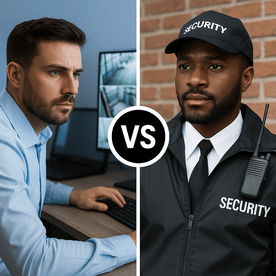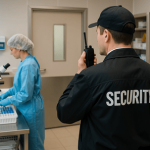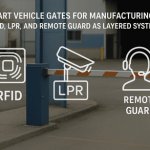
For manufacturing facilities, security isn’t a luxury—it’s a daily operational requirement. Whether you're dealing with valuable materials, safety compliance, or overnight shift coverage, maintaining real-time awareness of your site is essential.
Historically, many plants have relied on on-site security guards to handle this need. But as technology advances and budgets tighten, remote video monitoring (RVM) has emerged as a powerful, proactive alternative.
So which approach is right for your facility—or should you use both?
This article breaks down the strengths, limitations, and best-use cases for each solution, helping you make an informed decision based on your plant's layout, risk level, and operational goals.
k
k
👀 What Is Remote Video Monitoring?
Remote video monitoring combines surveillance cameras, intelligent analytics, and live monitoring by trained personnel—usually from a remote operations center.
Unlike passive camera systems that simply record video, RVM uses:
-
Motion detection or AI triggers
-
24/7 or scheduled live viewing
-
Real-time response workflows (e.g., audio warnings, alerts, dispatch)
RVM allows manufacturers to catch and respond to threats in real time—without someone physically on-site.
k
k
🧍♂️ What Do On-Site Guards Provide?
On-site guards perform physical patrols, enforce policy compliance, log visitors, and respond directly to incidents. They're familiar faces to your workforce and provide human intuition and adaptability.
Many plants still use guards at:
-
Facility entrances
-
Shipping and receiving zones
-
High-value storage areas
-
Overnight during shutdowns
But guards come with a cost premium, require training and supervision, and can’t be everywhere at once.
k
k
🔍 Remote Video Monitoring: 6 Key Benefits
1. Lower Long-Term Costs
Hiring and maintaining 24/7 on-site guards is expensive. RVM provides consistent coverage at a fraction of the cost, especially for facilities needing after-hours protection or multiple zones.
2. Wider, Simultaneous Coverage
Cameras don’t blink. RVM allows monitoring of dozens of areas at once, including blind spots, rooftops, and perimeter fencing—places guards might not patrol frequently.
3. Faster Detection & Response
AI video analytics can detect motion, intrusion, line-crossing, or loitering. RVM teams can issue live audio warnings ("You are being watched. Leave the area.") or escalate to police, often before damage is done.
4. Audit Trails and Evidence
Everything is recorded, logged, and time-stamped. This is invaluable for post-incident investigations, HR disputes, and compliance reporting.
5. Flexible and Scalable
Add new zones, cameras, or time windows as your plant evolves. You don’t need to re-staff—just expand your monitoring package.
6. No Downtime, No Distraction
Unlike guards, remote monitoring never takes breaks, misses handoffs, or gets pulled into side duties. It runs consistently and without fatigue.
k
k
👷 What On-Site Guards Still Do Best
Despite its advantages, RVM doesn’t replace every security need. Guards are irreplaceable in certain contexts:
• Physical Intervention
Only a guard can physically stop an intruder or escort someone off property.
• Complex Human Interaction
Guards handle visitor screening, contractor check-ins, or union-related interactions that require face-to-face judgment.
• Internal Escorting & Policy Enforcement
From enforcing badge use to monitoring PPE compliance in safety zones, guards offer real-time visibility and intervention in high-traffic areas.
k
k
🛠️ Hybrid Approach: Best of Both Worlds
For many manufacturing environments, the smartest move is to combine both systems:
-
Use remote monitoring to cover perimeters, entrances, unmanned gates, and low-traffic areas.
-
Use on-site guards at reception, docks, and during shift changes.
Integrating the two gives you:
-
Redundancy during high-risk hours
-
Broader visibility with fewer blind spots
-
Real-time alerts that guide guards toward issues faster
Example: RVM detects motion in a fenced yard after hours → issues a voice-down warning → notifies on-site guard or police.
k
k
🏁 Conclusion: Make Your Security Smarter, Not Just Bigger
Security isn’t one-size-fits-all. The right solution depends on:
-
Size and layout of your facility
-
Risk profile (e.g., valuable inventory, remote location, unionized labor)
-
Budget constraints
-
Shift schedules and access points
At SSP, we design custom security strategies that blend the best of human presence with cutting-edge surveillance. Whether you're looking to replace, supplement, or upgrade, we’ll help you implement the right mix for better outcomes—and lower risk.
👉 Interested in exploring remote video monitoring for your facility?


